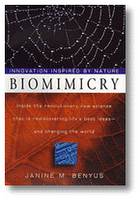
"A new power tool to face the environmental crisis and allows the emergence of sustainability" - Jean-Luc Roux
Biomimicry (from bios, meaning life, and mimesis, meaning to imitate) is a new science that studies nature's best ideas and then imitates these designs and processes to solve human problems. Studying a leaf to invent a better solar cell is an example. I think of it as "innovation inspired by nature."
The core idea is that nature, imaginative by necessity, has already solved many of the problems we are grappling with. Animals, plants, and microbes are the consummate engineers. They have found what works, what is appropriate, and most important, what lasts here on Earth. This is the real news of biomimicry: After 3.8 billion years of research and development, failures are fossils, and what surrounds us is the secret to survival.
Like the viceroy butterfly imitating the monarch, we humans are imitating the best and brightest organisms in our habitat. We are learning, for instance, how to harness energy like a leaf, grow food like a prairie, build ceramics like an abalone, self-medicate like a chimp, compute like a cell, and run a business like a hickory forest.
The conscious emulation of life's genius is a survival strategy for the human race, a path to a sustainable future. The more our world looks and functions like the natural world, the more likely we are to endure on this home that is ours, but not ours alone.
The energy input of the industrialise model is extreme and the toxic byproducts are odious.
Nature takes a different approach. Because an organism makes materials like bone or collagen or silk right in its own body, it doesn't make sense to "heat, beat, and treat." A spider, for instance, produces a waterproof silk that beats the pants off Kevlar for toughness and elasticity. Ounce for ounce, it's five times stronger than steel! But the spider manufactures it in water, at room temperature, using no high heats, chemicals, or pressures. Best of all, it doesn't need to drill offshore for petroleum; it takes flies and crickets at one end and produces this miracle material at the other. In a pinch, the spider can even eat part of its old web to make a new one.Imagine what this kind of a processing strategy would do for our fiber industry! Renewable raw materials, great fibers, and negligible energy and waste. We obviously have a lot to learn from an organism that has been making silk for some 380 million years.
The truth is, organisms have managed to do everything we want to do, without guzzling fossil fuels, polluting the planet, or mortgaging their future. What better models could there be? ( extract of Janine Benyus interview)
The Biomimicry Guild functions within an ecosystem~ we are subject to the same biological rules that govern the interactions of organisms that coexist in a common habitat. We are striving to evolve organizational dynamics that mimic mature ecosystems. As such, we:
1. Consider waste as a resource.
2. Diversify and cooperate to fully use the habitat.
3. Gather and use energy efficiently.
4. Optimize rather than maximize.
5. Use materials sparingly.
6. Don't foul our nest.
7. Don't draw down resources.
8. Remain in balance with biosphere.
9. Run on information.
10. Shop locally.
No comments:
Post a Comment